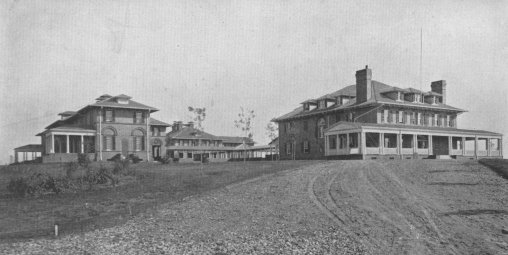|
|
|
||||||||||||||||||||||||||||||
|
Springfield State Hospital |
||||||||||||||||||||||||||||||
|
In 1894, the Legislature of the State of Maryland addressed the issue of overcrowding of the one state operated psychiatric hospital by creating a search committee charged with finding a site for the erection of the “Second Hospital for the Insane of Maryland”. This legislation was proposed by John Hubner of Baltimore County. After reviewing a number of potential sites, the committee selected Springfield, the estate of the Patterson-Brown family. At the time of this selection, Springfield was owned by Governor Frank Brown, a descendant of the William Patterson family, a wealthy colonial era farmer and merchant. William Patterson’s daughter, Elizabeth, or “Betsy”, gained international fame and notoriety when she married Jerome Bonaparte, brother of Napoleon Bonaparte. This courtship, and the ill-fated marriage that followed has been the subject of numerous books and at least one movie. Information about the Patterson and Brown families can be found in the Springfield Hospital Center Museum and the Maryland Historical Society. The first patients were received at the hospital in July 1896. Existing farm houses were renovated to accommodate those first patients while the hospital buildings were being constructed. The first phase of the building program was the Men’s Group, located in the northern section of the hospital grounds. A Women’s Group, located at the southern end of the campus was completed in 1900. As the hospital population rapidly expanded, additional buildings were erected, including the John Hubner Psychopathic Building, the Epileptic Colony, and significant expansions to the Men’s and Women’s Groups. Other structures were built to support the clinical areas. A powerhouse was constructed to supply domestic water needs as well as steam for heating. A large farm operation supplied most of the food consumed by patients and staff. A railroad line to Sykesville was built, and a small train was acquired to haul fuel and supplies. Additional structures were added to support the needs of the hospital, such as maintenance buildings, central dietary and storeroom, firehouse, and employee housing. By the late 1940’s and early 1950’s, the hospital population exceeded 3000. Units were overcrowded and staffing was inadequate to meet the needs of the patients. A series of newspaper articles in The Baltimore Sun, entitled “Maryland’s Shame”, examined these problems at all of the state operated psychiatric hospitals. As a result of these articles and a heightened awareness by the public of the needs of the mentally ill, additional funding for staffing and capital improvements was made by the Maryland Legislature. At Springfield Hospital Center, this effort resulted in the construction of many new buildings, and renovations to all existing buildings to remedy the overcrowding. More history... Today select sections of the hospital are still in use and very active. Some buildings have been sold to private businesses and are in the process of being renovated, other are still owned by the hospital and sit empty as nature slowly destroys them. |
||||||||||||||||||||||||||||||
 |
||||||||||||||||||||||||||||||
|
||||||||||||||||||||||||||||||
|
||||||||||||||||||||||||||||||
|
[BACK] |































